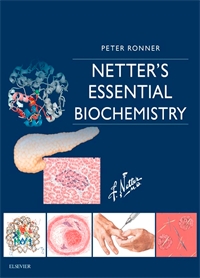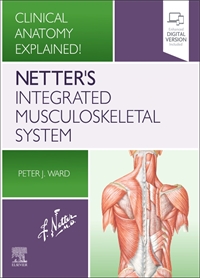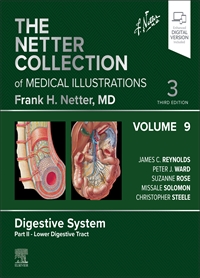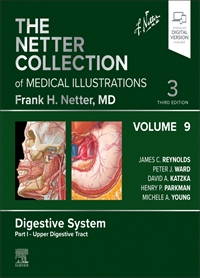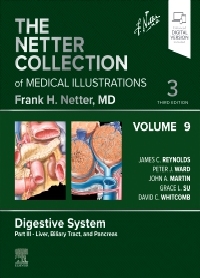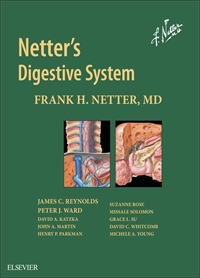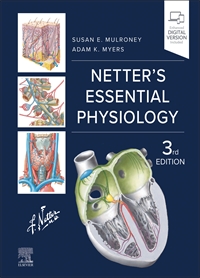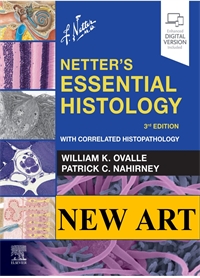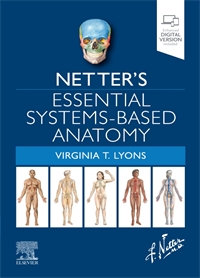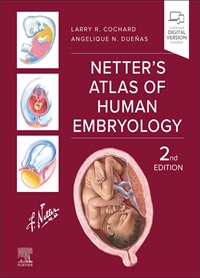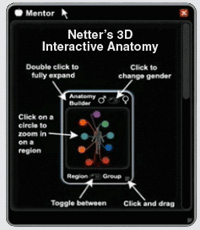Netter's Essential Biochemistry
Author: Peter Ronner
ISBN: 9781929007639
- Page 1: Structures of deoxyribonucleotides found in DNA
- Page 2: The structure and polarity of a single strand of DNA
- Page 3: Hydrogen bonding between complementary bases
- Page 4: Basic structure of double-stranded DNA
- Page 5: The double-helical structure of DNA
- Page 6: Packing of DNA into a nucleosome core particle in the nucleus
- Page 7: Strain imposed on double-helical DNA when the helix is opened up partially, or when a non-rotatable object moves in between the two complementary strands
- Page 8: Topoisomerase I cuts one strand of DNA and swivels around the other strand
- Page 9: Reaction catalyzed by topoisomerase II
- Page 10: Human topoisomerase IIα catalyzes the passage of one DNA strand through another DNA strand
- Page 11: Bronchogenic Carcinoma: Small Cell Anaplastic (Oat Cell) Type
- Page 12: Normal male karyotype
- Page 13: Spontaneous alterations of DNA that are repaired by the base-excision repair pathway
- Page 14: The short-patch base-excision repair pathway
- Page 15: Causes of base mismatches that are repaired by the mismatch repair pathway
- Page 16: DNA mismatch repair
- Page 17: Large Intestine Structure Mucosa and Musculature of Colon Mucosa and Musculature of Large Intestine Structure of Colon
- Page 18: Melanoma
- Page 19: Bronchogenic Carcinoma: Squamous Cell Type
- Page 20: Cisplatin-induced intrastrand crosslinking between two adjacent guanine bases
- Page 21: Testicular Tumors I - Seminoma, Embryonal Carcinoma
- Page 22: Nucleotide excision repair of intrastrand crosslinks
- Page 23: Radiation Therapy
- Page 26: Overview of DNA repair pathways
- Page 27: DNA replication is semi-conservative
- Page 28: DNA replication occurs 5? to 3? and is stopped by incorporated synthetic dideoxyribonucleotides that lack the 3? hydroxyl group
- Page 29: Replication forks during DNA replication
- Page 30: Primer synthesis during DNA replication
- Page 31: DNA replication, showing leading and lagging strand at a replication fork
- Page 32: Drugs that preferentially inhibit DNA synthesis in retroviruses
- Page 33: Drugs that inhibit DNA replication
- Page 34: Metaphase chromosomes with telomeres
- Page 35: Structure of a telomere
- Page 36: Telomere shortening and lengthening
- Page 37: Abnormal karyogram of a bone marrow cell from a patient with acute myeloid leukemia (AML)
- Page 38: Example of Fluorescence in situ hybridization (FISH) to interphase chromosomes
- Page 39: Primer-directed in vitro DNA synthesis
- Page 40: Principle of the PCR amplification of a DNA sequence
- Page 41: Quantitative PCR amplification
- Page 42: Standard curve for real-time PCR that relates analyte concentration to threshold cycle
- Page 43: Digestion of PCR-amplified DNA with a restriction enzyme
- Page 44: Melting curve analysis
- Page 45: Microarray analysis of chromosome 1
- Page 46: Sample result of Sanger sequencing of a lung nodule
- Page 47: Processed results of massive parallel sequencing
- Page 48: Electron Micrograph of a Lymphocyte
- Page 49: Maintenance of CpG methylation, an epigenetic modification
- Page 50: Genes in a chromosome can be oriented in two ways
- Page 51: The promoter upstream of a gene
- Page 52: The structure of the liver X receptor-retinoid X receptor transcription factor bound to DNA
- Page 53: SREBP-1a as an example of a transcription factor that uses a leucine zipper to dimerize
- Page 54: Model of general transcription factors that are part of a preinitiation complex
- Page 55: Capping of RNA with methylated guanosine triphosphate
- Page 56: Polyadenylation of RNA
- Page 57: Use of an upstream poly(A) site leads to termination of transcription and a shortened 3′-UTR
- Page 58: Use of upstream poly(A) site leads to termination of transcription and a reduced number of exons, altering protein structure
- Page 59: Basic requirements for splicing of pre-mRNA
- Page 60: Basic modes of alternative splicing
- Page 61: Alternative splicing of glucocorticoid receptor pre-mRNA
- Page 62: From DNA to RNA to protein
- Page 63: Export of mRNP complexes from the nucleus
- Page 64: Structure of human tRNASec.
- Page 65: Structure of a typical mRNA
- Page 66: Peptide synthesis in ribosomes
- Page 67: miRNA-induced degradation of mRNA
- Page 68: Higher Magnification Electron Micrograph Showing Details of the Rough Endoplasmic Reticulum
- Page 69: Transfer of a growing peptide chain into the endoplasmic reticulum
- Page 70: Synthesis of a 14-residue glycan for N-linked glycosylation in the endoplasmic reticulum
- Page 71: N-glycosylation of the asparagine side chain of a protein
- Page 72: Transport of proteins between intracellular compartments by coated vesicles
- Page 73: Basic principle of vesicle formation and protein sorting in the ER and Golgi
- Page 74: The cell cycle and its phase-specific kinase activities
- Page 75: Phosphorylation of RB by CDKs releases the transcription factor E2F
- Page 76: Growth factor signaling
- Page 77: DNA damage and the p53 pathway
- Page 78: The WNT / β-catenin pathway
- Page 79: The role of MYC in the cell cycle
- Page 80: Apoptosis. DISC: death-inducing signaling complex. APAF: Apoptotic protease activating factor 1
- Page 81: Age as a key risk factor for cancer
- Page 82: Relative risk for cancer in select organs
- Page 83: Mammary Gland
- Page 84: In Situ Carcinomas of Breast (DCIS and LCIS)
- Page 85: Bronchogenic Carcinoma: Squamous Cell Type
- Page 86: Bronchogenic Carcinoma: Adenocarcinoma
- Page 87: Bronchogenic Carcinoma; Large Cell Anaplastic Type
- Page 88: Carcinoma of Prostate I - Types and Extension
- Page 89: Familial Polyposis of Large Intestine
- Page 90: Malignant Tumors of Large Intestine
- Page 91: Melanoma
- Page 92: A coronal fused image of 2-18F-deoxyglucose-based positron emission tomography (PET) and computed tomography (CT, obtained with x-rays) of a patient with squamous cell carcinoma of the cervix
- Page 93: L- and D-amino acids
- Page 94: Structures of the amino acids that ribosomes incorporate into nascent peptide chains
- Page 95: The nature of the peptide bond
- Page 96: Hydrogen bonding in proteins
- Page 97: Conformation of an -helix in human -globin
- Page 98: Cartoons of human serum albumin complexed to fatty acids
- Page 99: SNARE proteins can form a coiled coil
- Page 100: Model of the crystal structure of human brain fatty acid binding protein in complex with oleic acid
- Page 101: Model of Aβ40 fibrils grown in vitro using seeds from the brain of an Alzheimer patient
- Page 102: Amyloidogenesis in Alzheimer's Disease
- Page 103: Parkinson's Disease
- Page 104: The effect of an enzyme on the energy diagram of a chemical reaction
- Page 105: Induced fit in glucokinase
- Page 106: Activity of two different enzymes as a function of substrate concentration and as predicted by the Michaelis-Menten equation
- Page 107: Enzyme activity as predicted by a modified Michaelis-Menten equation for enzymes that show cooperativity towards their substrate
- Page 108: Normal and abnormal regulation of flux through a metabolic pathway
- Page 109: Basic principle of the enzyme-linked immunosorbent assay (ELISA)
- Page 110: Classification of phospholipids and sphingolipids
- Page 111: The structure of head groups in diacylglycerophospholipids and plasmalogens
- Page 112: The structure of a cardiolipin
- Page 113: The structure of cholesterol
- Page 114: The basic structure of a lipid bilayer membrane
- Page 116: Enzymes that maintain or abolish the asymmetric distribution of phospholipids in bilayer membranes
- Page 117: Intrahepatic Cholestasis
- Page 118: Part of the human β2-adrenergic receptor
- Page 119: Proteins that are tethered to the inner leaflet of the plasma membrane
- Page 120: GPI-anchored proteins are tethered to the outer leaflet of the plasma membrane
- Page 121: Overview of the processing of a fibrillar preprocollagen in the endoplasmic reticulum
- Page 122: Posttranslational formation of hydroxyproline and hydroxylysine in procollagen
- Page 123: In the extracellular space, processing of procollagen trimers and aggregation of collagen triple helices yields collagen microfibrils
- Page 125: Achondroplasia
- Page 126: Vitamin C Deficiency (Scurvy)
